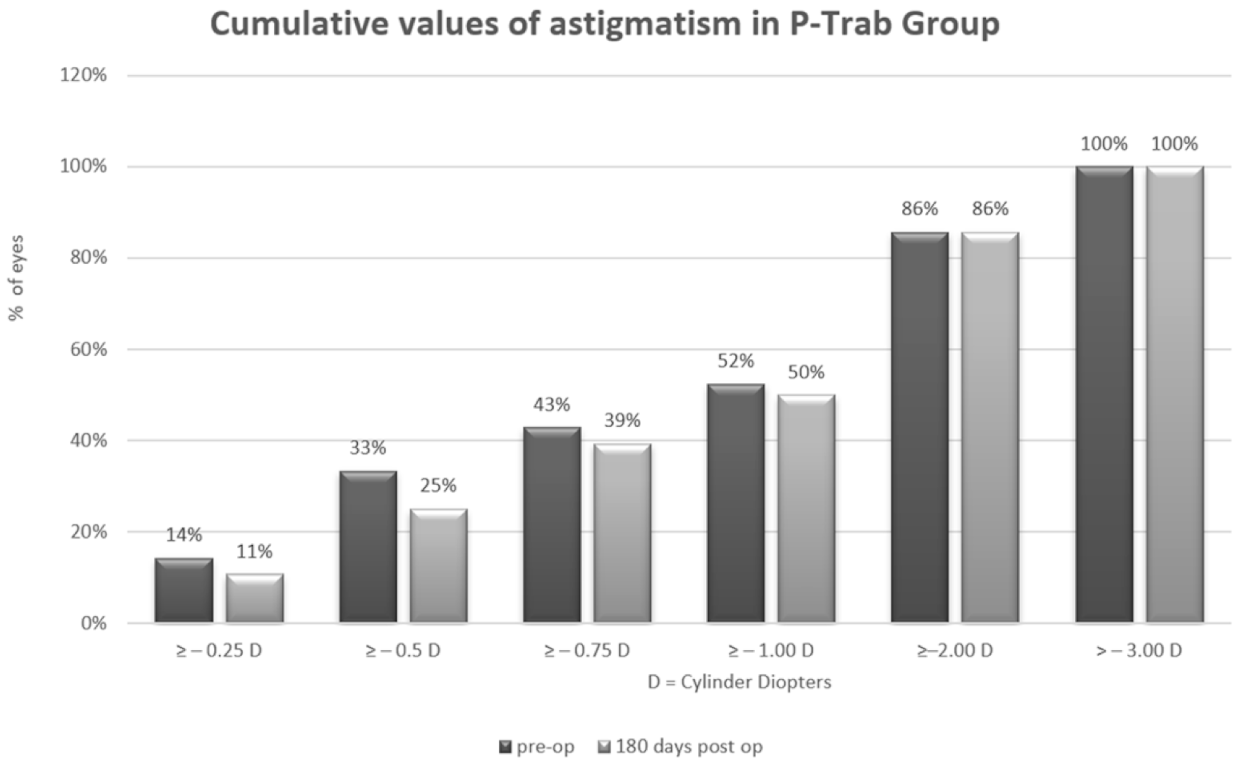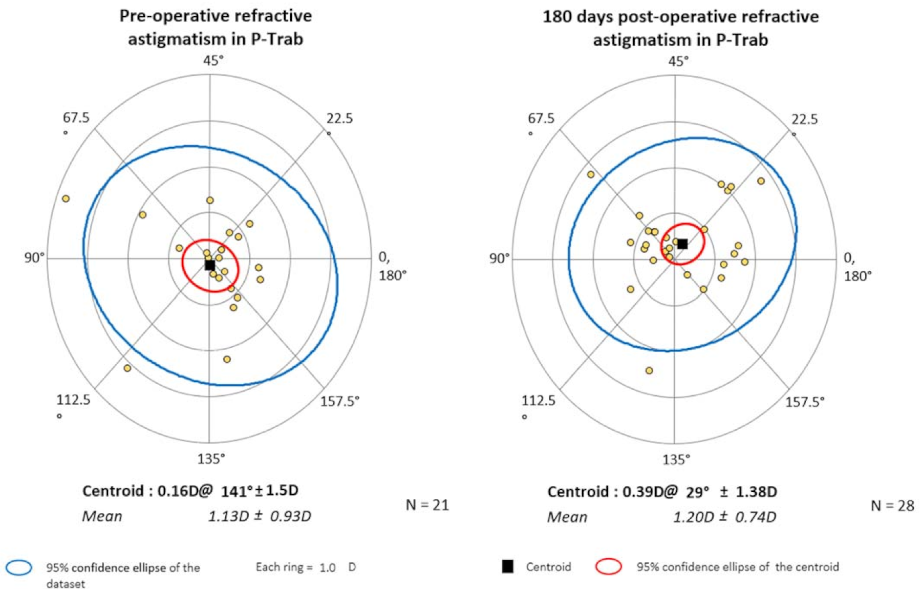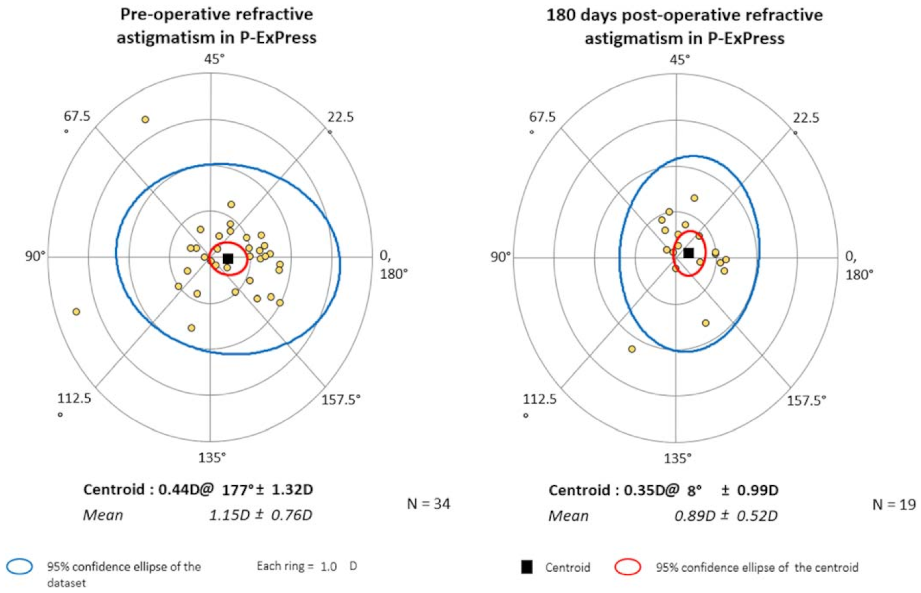Phacotrabeculectomy versus Phaco with Implantation of the Ex-PRESS Device: Surgical and Refractive Outcomes—A Randomized Controlled Trial
Abstract
:1. Introduction
2. Materials and Methods
2.1. Patients
2.2. Preoperative Examination
2.3. Surgical Technique
2.4. Postoperative Protocol
2.5. Refractive Data Evaluation
| cyl = √(x2 + y2) | ||
| angle = ½ × [tan−1 (y/x)] | ||
| if x > 0 and y > 0 | → | axis = angle |
| if x < 0 | → | axis = angle + 90° |
| if x > 0 and y < 0 | → | axis = angle + 180° |
| if x = 0 and y < 0 | → | axis = 135° |
| if x = 0 and y > 0 | → | axis = 45° |
| if x = 0 and y = 0 | → | axis = 0° |
| if y = 0 and x < 0 | → | axis = 90° |
| if y = 0 and x > 0 | → | axis = 0°. |
2.6. Statistical Evaluation
3. Results
3.1. Intraocular Pressure
3.2. IOP-Lowering Drugs
3.3. Surgical Success
3.4. Best-Corrected Visual Acuity
3.5. Complications and Additional Procedures
3.6. Refractive Analysis of Astigmatism
3.7. Vector Analysis of Astigmatism
4. Discussion
5. Conclusions
Author Contributions
Funding
Institutional Review Board Statement
Informed Consent Statement
Data Availability Statement
Conflicts of Interest
References
- Traverso, C.E.; De Feo, F.; Messas-Kaplan, A.; Denis, P.; Levartovsky, S.; Sellem, E.; Badalà, F.; Zagorski, Z.; Bron, A.; Gandolfi, S.; et al. Long term effect on IOP of a stainless steel glaucoma drainage implant (Ex-PRESS) in combined surgery with phacoemulsification. Br. J. Ophthalmol. 2005, 89, 425–429. [Google Scholar] [CrossRef] [PubMed] [Green Version]
- Netland, P.A.; Sarkisian. S.R.; Moster, M.R.; Ahmed, I.I.; Condon, G.; Salim, S.; Sherwood, M.B.; Siegfried, C.J. Randomized, prospective, comparative trial of EX-PRESS glaucoma filtration device versus trabeculectomy (XVT study). Am J. Ophthalmol. 2014, 157, 433–440.e3. [Google Scholar] [CrossRef] [PubMed]
- Tzu, J.H.; Shah, C.T.; Galor, A.; Junk, A.K.; Sastry, A.; Wellik, S.R. Refractive outcomes of combined cataract and glaucoma surgery. J. Glaucoma 2015, 24, 161–164. [Google Scholar] [CrossRef]
- Chan, H.H.L.; Kong, Y.X.G. Glaucoma surgery and induced astigmatism: A systematic review. Eye Vis. (Lond.) 2017, 4, 27. [Google Scholar] [CrossRef] [PubMed] [Green Version]
- Moschos, M.M.; Chatziralli, I.P.; Tsatsos, M. One-site versus two-site phacotrabeculectomy: A prospective randomized study. Clin. Interv. Aging 2015, 10, 1393–1399. [Google Scholar] [CrossRef] [PubMed] [Green Version]
- Hugkulstone, C.E. Changes in keratometry following trabeculectomy. Br. J. Ophthalmol. 1991, 75, 217–218. [Google Scholar] [CrossRef] [Green Version]
- Cravy, T.V. Calculation of the change in corneal astigmatism following cataract extraction. Ophthalmic Surg. 1979, 10, 38–49. [Google Scholar]
- Cashwell, L.F.; Martin, C.A. Axial length decrease accompanying successful glaucoma filtration surgery. Ophthalmology 1999, 106, 2307–2311. [Google Scholar] [CrossRef]
- Claridge, K.G.; Galbraith, J.K.; Karmel, V.; Bates, A.K. The effect of trabeculectomy on refraction, keratometry and corneal topography. Eye (Lond.) 1995, 9, 292–298. [Google Scholar] [CrossRef]
- Park, S.H.; Park, K.H.; Kim, J.M.; Choi, C.Y. Relation between axial length and ocular parameters. Ophthalmologica 2010, 224, 188–193. [Google Scholar] [CrossRef]
- Stawowski, Ł.; Konopińska, J.; Deniziak, M.; Saeed, E.; Zalewska, R.; Mariak, Z. Comparison of ExPress mini-device implantation alone or combined with phacoemulsification for the treatment of open-angle glaucoma. J. Ophthalmol. 2015, 2015, 613280. [Google Scholar] [CrossRef] [PubMed] [Green Version]
- Byszewska, A.; Konopińska, J.; Kicińska, A.K.; Mariak, Z.; Rękas, M. Canaloplasty in the treatment of primary open-angle glaucoma: Patient selection and perspectives. Clin. Ophthalmol. 2019, 13, 2617–2629. [Google Scholar] [CrossRef] [PubMed]
- Holladay, J.T.; Maverick, K.J. Relationship of the actual thick intraocular lens optic to the thin lens equivalent. Am. J. Ophthalmol. 1998, 126, 339–347. [Google Scholar] [CrossRef]
- Tanito, M.; Matsuzaki, Y.; Ikeda, Y.; Fujihara, E. Comparison of surgically induced astigmatism following different glaucoma operations. Clin. Ophthalmol. 2017, 11, 2113–2120. [Google Scholar] [CrossRef] [Green Version]
- Hammel, N.; Lusky, M.; Kaiserman, I.; Robinson, A.; Bahar, I. Changes in anterior segment parameters after insertion of Ex-PRESS miniature glaucoma implant. J. Glaucoma 2013, 22, 565–568. [Google Scholar] [CrossRef]
- Razeghinejad, M.R.; Dehghani, C. Effect of ocular hypotony secondary to cyclodialysis cleft on corneal topography. Cornea 2008, 27, 609–611. [Google Scholar] [CrossRef]
- Hornová, J. Trabeculectomy with releasable sutures and corneal topography. Ceske Slov. Oftalmol. 1998, 54, 368–372. [Google Scholar]
- Law, S.K.; Mansury, A.M.; Vasudev, D.; Caprioli, J. Effects of combined cataract surgery and trabeculectomy with mitomycin C on ocular dimensions. Br. J. Ophthalmol. 2005, 89, 1021–1025. [Google Scholar] [CrossRef] [Green Version]
- Francis, B.A.; Wang, M.; Lei, H.; Du, L.T.; Minckler, D.S.; Green, R.L.; Roland, C. Changes in axial length following trabeculectomy and glaucoma drainage device surgery. Br. J. Ophthalmol. 2005, 89, 17–20. [Google Scholar] [CrossRef] [Green Version]
- Cunliffe, I.A.; Dapling, R.B.; West, J.; Longstaff, S. A prospective study examining the changes in factors that affect visual acuity following trabeculectomy. Eye (Lond.) 1992, 6, 618–622. [Google Scholar] [CrossRef]
- Lima, V.C.; Prata, T.S.; Castro, D.P.; Castro, L.C.; De Moraes, C.G.; Mattox, C.; Rosen, R.B.; Liebmann, J.M.; Ritch, R. Macular changes detected by Fourier-domain optical coherence tomography in patients with hypotony without clinical maculopathy. Acta Ophthalmol. 2011, 89, e274–e277. [Google Scholar] [CrossRef] [PubMed]
- Delbeke, H.; Stalmans, I.; Vandewalle, E.; Zeyen, T. The effect of trabeculectomy on astigmatism. J. Glaucoma 2016, 25, e308–e312. [Google Scholar] [CrossRef] [PubMed]




| Group. | P-ExPress | P-Trab | P * |
|---|---|---|---|
| Follow-up (months) | 6.7 ± 0.4 | 6.9 ± 0.5 | 0.249 |
| Number | 43 | 38 | - |
| Age (years) | 72.1 ± 4.62 | 67.2 ± 9.28 | 0.374 |
| Sex (female/male) | 26/17 | 28/10 | 0.579 |
| Eye (right/left) | 23/20 | 17/21 | 0.658 |
| Glaucoma Type | |||
| POAG | 27 | 21 | 0.482 |
| PEX | 14 | 17 | |
| Pigmentary | 2 | 0 | |
| LOCS III scale (NC1/NC2/NC3) | 12/23/6 | 11/20/7 | 0.768 |
| Time | P-ExPress | P-Trab | P * | ||||
|---|---|---|---|---|---|---|---|
| Mean (SD) | Median | Range | Mean (SD) | Median | Range | ||
| Pre-op | 25.3 ± 7.1 | 25.00 | 12–50 | 26.8 ± 11.3 | 25.00 | 12–62 | 0.877 |
| 1st day | 16.7 ± 8.0 | 16.00 | 4–29 | 15.7 ± 7.1 | 16.00 | 3–31 | 0.867 |
| 7th day | 15.2 ± 6.6 | 14.00 | 7–23 | 16.9 ± 4.8 | 18.00 | 3–19 | 0.236 |
| 1st month | 17.6 ± 10.2 | 16.00 | 8–27 | 17.3 ± 8.2 | 16.00 | 10–26 | 0.653 |
| 3rd month | 14.9 ± 3.2 | 16.00 | 5–23 | 14.5 ± 4.1 | 15.00 | 7–24 | 0.645 |
| 6th month | 15.1 ± 4.3 | 15.00 | 7–22 | 15.9 ± 2.9 | 16.00 | 8–23 | 0.281 |
| Time | P-ExPress | P-Trab | P * | ||||
|---|---|---|---|---|---|---|---|
| Mean (SD) | Median | Range | Mean (SD) | Median | Range | ||
| Pre-op | 2.91 ± 0.9 | 3.0 | 2–4 | 3.26 ± 0.8 | 3.0 | 3–4 | 0.79 |
| 6 mo. | 0.46 ± 1 | 0 | - | 1.39 ± 1.2 | 2 | 0–2 | 0.3 |
| Time | P-ExPress | P-Trab | P * | ||||
|---|---|---|---|---|---|---|---|
| Mean (SD) | Median | Range | Mean (SD) | Median | Range | ||
| Pre-op | 0.53 ± 0.55 | 0.30 | 0–2.4 | 0.48 ± 0.5 | 0.16 | 0–2 | 0.68 |
| 6 mo. | 0.22 ± 0.42 | 0.1 | 0–1.7 | 0.17 ± 0.28 | 0.05 | 0–1.4 | 0.57 |
| P-ExPress n (%) | P-Trab n (%) | P * | |
|---|---|---|---|
| Intraoperative | |||
| Bleeding | - | 1 (2.6) | 0.645 |
| Postoperative | |||
| Hyphema | |||
| blood level in AC | 1 (2.1) | 1 (2.6) | 0.875 |
| erythrocytes in AC | - | - | - |
| Wound leakage | 3 (6.5) | 1 (2.6) | 0.391 |
| Fibrosis | 9 (19.6) | 9 (23.1) | 0.784 |
| Anterior chamber cells | 3 (6.5) | 3 (7.7) | 0.834 |
| Hypotony | |||
| until 7 days | - | 2 (5.1) | 0.115 |
| until 30 days | - | 1 (2.6) | 0.411 |
| until 180 days | 1 (2.1) | 1 (2.6) | 0.896 |
| Choroid detachment | 1 (2.1) | 3 (7.7) | 0.231 |
| Macular edema | 1 (2.1) | - | 0.354 |
| Time | P-ExPress | P-Trab | P * | ||||
|---|---|---|---|---|---|---|---|
| Mean | Median | SD | Mean | Median | SD | ||
| Pre-op | 1.15 | 1.0 | 0.76 | 1.13 | 0.75 | 0.93 | 0.175 |
| 6 mo. | 0.89 | 0.87 | 0.52 | 1.20 | 1.06 | 0.75 | 0.2 |
| Time | P-ExPress | P-Trab | P * | ||||
|---|---|---|---|---|---|---|---|
| Centroid | Axis | Trend | Centroid | Axis | Trend | ||
| Pre-op | 0.44 | 177.42 | ATR | 0.16 | 140.61 | OBLIQUE | 0.5 |
| 6 mo. | 0.35 | 7.71 | ATR | 0.39 | 29.47 | OBLIQUE | 0.38 |
Publisher’s Note: MDPI stays neutral with regard to jurisdictional claims in published maps and institutional affiliations. |
© 2021 by the authors. Licensee MDPI, Basel, Switzerland. This article is an open access article distributed under the terms and conditions of the Creative Commons Attribution (CC BY) license (http://creativecommons.org/licenses/by/4.0/).
Share and Cite
Konopińska, J.; Byszewska, A.; Saeed, E.; Mariak, Z.; Rękas, M. Phacotrabeculectomy versus Phaco with Implantation of the Ex-PRESS Device: Surgical and Refractive Outcomes—A Randomized Controlled Trial. J. Clin. Med. 2021, 10, 424. https://doi.org/10.3390/jcm10030424
Konopińska J, Byszewska A, Saeed E, Mariak Z, Rękas M. Phacotrabeculectomy versus Phaco with Implantation of the Ex-PRESS Device: Surgical and Refractive Outcomes—A Randomized Controlled Trial. Journal of Clinical Medicine. 2021; 10(3):424. https://doi.org/10.3390/jcm10030424
Chicago/Turabian StyleKonopińska, Joanna, Anna Byszewska, Emil Saeed, Zofia Mariak, and Marek Rękas. 2021. "Phacotrabeculectomy versus Phaco with Implantation of the Ex-PRESS Device: Surgical and Refractive Outcomes—A Randomized Controlled Trial" Journal of Clinical Medicine 10, no. 3: 424. https://doi.org/10.3390/jcm10030424







